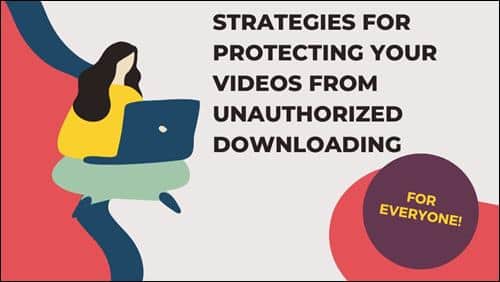
Video content online has become increasingly popular over the last few years. It’s a great way to share information, entertain, and educate people around the world. However, as video content becomes more popular, it has also become more vulnerable to unauthorized downloading and sharing. This has become a major problem for content creators, as it can lead to lost revenue and infringements of copyright. Fortunately, there are a few steps you can take to protect your video from download and ensure your content remains secure.
Understand Your Rights
The first step to protecting your video content from download is to understand your rights. As the creator of the content, you are the copyright holder and have the right to control how and when your content is used. This means you can prevent people from downloading and sharing your videos without your permission. It’s important to be aware of the laws in your country or region, as they may vary from place to place.
Create A Watermark
One of the most effective ways to protect video from download is to create a watermark. A watermark is a logo or text that’s added to your video as a form of identification. It’s typically placed in a prominent location on the video, such as the corner or the center. By adding a watermark, you make it difficult for people to download and share your video without your permission. It also serves as a deterrent, as it will make it obvious to viewers that the video is copyrighted and shouldn’t be shared without your permission.
Use Digital Rights Management (DRM)
Another way to protect video from download is to use digital rights management (DRM) software. DRM is a type of software that can be used to restrict access to digital media. It works by preventing unauthorized downloads and sharing of content. For example, you can use DRM to prevent people from downloading or sharing your videos on social media and other websites.
Disable Video Downloaders
There are many video downloaders available online that allow people to easily download and share videos without your permission. To prevent people from using these tools, you can disable them. This can be done by disabling the video downloader’s JavaScript or by using a script blocker. Disabling video downloaders is a good way to protect video from download without having to use DRM.
Embed Password Protection
Password protection is another way to protect video from download. This is a type of encryption that requires users to enter a password to access your content. This can help prevent unauthorized downloads and sharing of your video. You can embed password protection into your videos by using an encoding software.
Use A Content Delivery Network (CDN)
Content delivery networks (CDNs) are networks of servers that can be used to deliver content to users. They are a good way to protect video from download, as they can limit access to your content and prevent unauthorized downloads. CDNs can also help reduce buffering and improve the speed of your video streaming.
Conclusion
Protecting video from download is essential to ensure your content remains secure and you don’t lose out on potential revenue. There are a few steps you can take to protect your video, such as creating a watermark, using DRM software, disabling video downloaders, embedding password protection, and using a CDN. By following these steps, you can ensure your video content remains secure and you don’t lose out on potential revenue.
Leave a Reply
You must be logged in to post a comment.